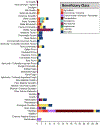Connecting stakeholder priorities and desired environmental attributes for wetland restoration using ecosystem services and a heat map analysis for communications
- PMID: 38628570
- PMCID: PMC11018255
- DOI: 10.3389/fevo.2024.1290090
Connecting stakeholder priorities and desired environmental attributes for wetland restoration using ecosystem services and a heat map analysis for communications
Abstract
Framing ecological restoration and monitoring goals from a human benefits perspective (i.e., ecosystem services) can help inform restoration planners, surrounding communities, and relevant stakeholders about the direct benefits they may obtain from a specific restoration project. We used a case study of tidal wetland restoration in the Tillamook River watershed in Oregon, USA, to demonstrate how to identify and integrate community stakeholders/beneficiaries and the environmental attributes they use to inform the design of and enhance environmental benefits from ecological restoration. Using the U.S. Environmental Protection Agency's Final Ecosystem Goods and Services (FEGS) Scoping Tool, we quantify the types of ecosystem services of greatest common value to stakeholders/beneficiaries that lead to desired benefits that contribute to their well-being in the context of planned uses that can be incorporated into the restoration project. This case study identified priority stakeholders, beneficiaries, and environmental attributes of interest to inform restoration goal selection. This novel decision context application of the FEGS Scoping Tool also included an effort focused on how to communicate the connections between stakeholders, and the environmental attributes of greatest interest to them using heat maps.
Keywords: decision-making; ecosystem services; nature’s benefits; restoration; stakeholders; tidal wetlands.
Conflict of interest statement
Conflict of interest The authors declare that the research was conducted in the absence of any commercial or financial relationships that could be construed as a potential conflict of interest.
Figures






Similar articles
-
Ecosystem Services Profiles for Communities Benefitting from Estuarine Habitats along the Massachusetts Coast, USA.Ecol Inform. 2023 Nov 1;77:1-20. doi: 10.1016/j.ecoinf.2023.102182. Ecol Inform. 2023. PMID: 38487338 Free PMC article.
-
Identifying and Aligning Ecosystem Services and Beneficiaries Associated with Best Management Practices in Chesapeake Bay Watershed.Environ Manage. 2022 Feb;69(2):384-409. doi: 10.1007/s00267-021-01561-z. Epub 2022 Jan 4. Environ Manage. 2022. PMID: 34981171 Free PMC article.
-
The final ecosystem goods and services Voltron: the power of tools together.Front Ecol Evol. 2023 Dec 21;11:1-16. doi: 10.3389/fevo.2023.1290662. Front Ecol Evol. 2023. PMID: 38516293 Free PMC article.
-
Wetland phosphorus dynamics and phosphorus removal potential.Water Environ Res. 2022 Oct;94(10):e10799. doi: 10.1002/wer.10799. Water Environ Res. 2022. PMID: 36259138 Review.
-
Identifying ecological production functions for use in ecosystem services-based environmental risk assessment of chemicals.Sci Total Environ. 2021 Oct 15;791:146409. doi: 10.1016/j.scitotenv.2021.146409. Epub 2021 Mar 13. Sci Total Environ. 2021. PMID: 33771395 Review.
Cited by
-
Editorial: Modeling the human well-being benefits of ecosystem restoration and management for environmental decision making.Front Ecol Evol. 2024 Aug 14;12:1456660. doi: 10.3389/fevo.2024.1456660. Front Ecol Evol. 2024. PMID: 39381716 Free PMC article. No abstract available.
References
-
- Ackerman R, Neuenfeldt R, Eggermont T, Burbidge M, Lehrman J, Wells N, et al. (2016). Resilience of Oregon coastal communities in response to external stressors. M.S. Thesis. Ann Arbor, MI: University of Michigan.
-
- Belton V, and Stewart T (2002). Multiple criteria decision analysis: An integrated approach (Boston, MA: Kluwer Academic Publishers; ), 372 p. doi: 10.1007/978-1-4615-1495-4 - DOI
-
- Boyd J, and Banzhaf S (2007). What are ecosystem services? The need for standardized environmental accounting units. Ecol. Econ 63, 616–626. doi: 10.1016/j.ecolecon.2007.01.002 - DOI
-
- Brophy LS (2019). Comparing historical losses of forested, scrub-shrub, and emergent tidal wetlands on the Oregon coast, USA: A paradigm shift for estuary restoration and conservation (Corvallis, OR: Institute for Applied Ecology; ).
Grants and funding
LinkOut - more resources
Full Text Sources
